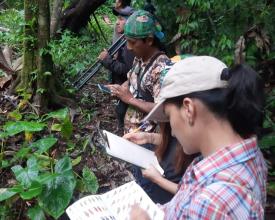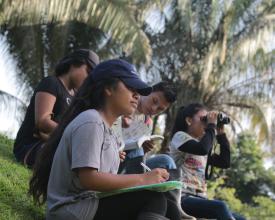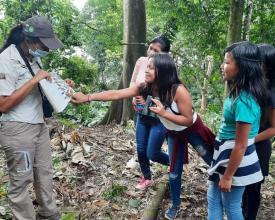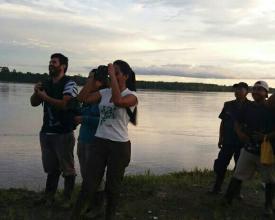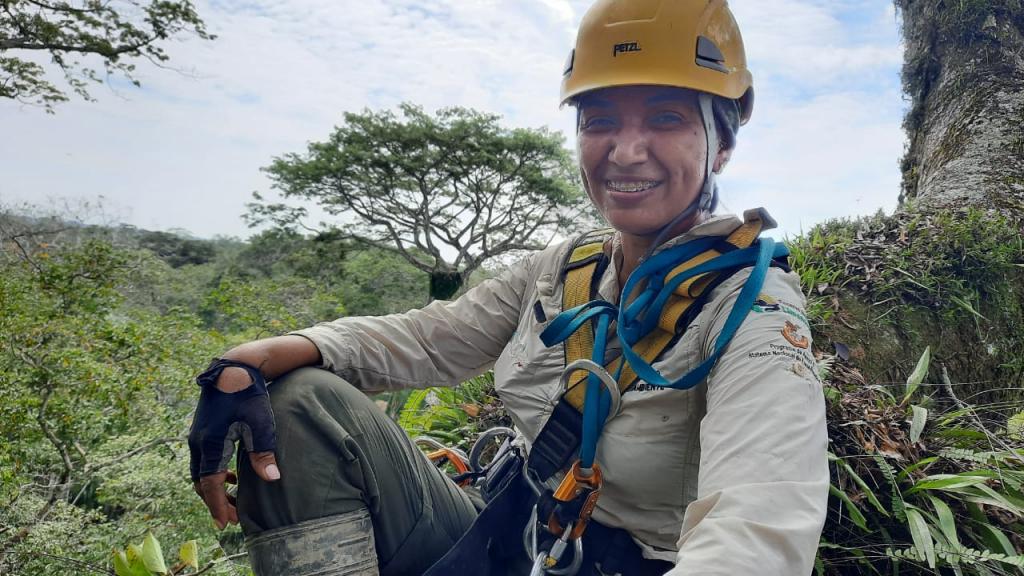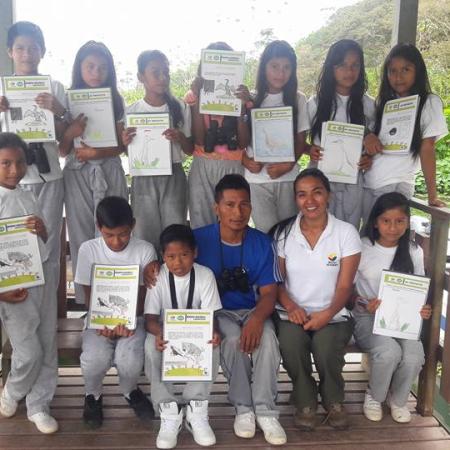
Participatory monitoring, a conservation strategy in the Limoncocha Biological Reserve
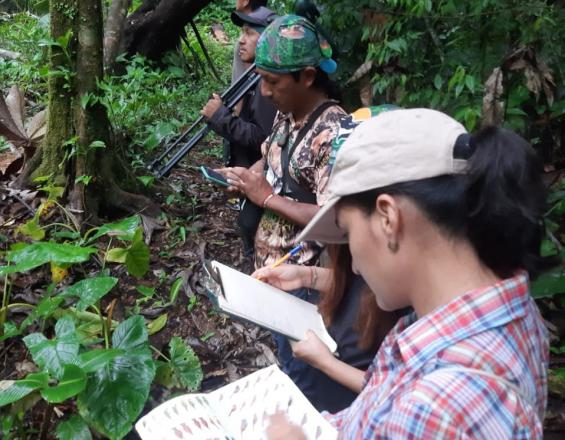
Limoncocha Biological Reserve being a RAMSAR site, in 2016 with the support of Aves y Conservación implemented participatory monitoring of wetlands, where monitoring protocols were established for easy implementation so that they can be applied by people who do not have a vast scientific technical knowledge on the subject, the protocols were established for monitoring birds, fish and aquatic macroinvertebrates.
With the growing interest on bird watching in 2017 we started to participate in two bird counts of international importance, the "Global Big Day", organized by Cornell University, and Limoncocha was registered as one of the official sites in Ecuador for the "AUDUBOM Christmas bird count", routes were established within the PA and in its area of influence. The participatory counts are intended to position Limoncocha as a birding destination and to encourage the local population to participate in this type of activity and benefit from it.
Context
Challenges addressed
One of the main challenges of monitoring is continuity, because in order to have the desired success, monitoring must be maintained over time, and in addition to being participatory it must capture the attention of the people of the community so that they feel involved in this activity in an active way, and in the future it would be desirable that they can be part of the organization of the activity.
Another challenge is to somehow involve people who are not interested in bird monitoring, so that they can benefit from this activity in some other way, for example, they could be part of the people who offer services such as food and beverages.
In the financial area, a budget should be obtained so that the community guides can have their equipment for bird watching.
Location
Process
Summary of the process
The main components of this experience are wetland monitoring and the participatory factor. The relationship between these pillars is based on the fact that the wetland monitoring data is obtained through the integration of people from outside the protected area. This generates a mutual benefit, because the protected area is able to collect information that will be useful for decision making, and the people who collaborate in the activity learn about monitoring, which has caused great interest, especially in the area of birds. Another element that is implicit in this experience is environmental education; by becoming actively involved in the protected area's activities, people acquire environmental awareness about the place, the species, and the threats.
Building Blocks
Bird monitoring
It is the biological part that has to do with the monitoring of birds, which provides information to know how the wetland is. It seeks to involve young people from local communities and people interested in counting birds, after training, to participate with the staff of the protected area in the monitoring of bird species.
Enabling factors
- Definition of a monitoring plan based on experiences developed by specialized institutions.
- Preparation of monitoring protocols that can be easily implemented by the park rangers of the protected area.
Development of visits and bird watching tours, with an organized and technical record of the information collected.
Lesson learned
- The establishment of biological monitoring protocols that are easy to apply helps to get people interested in collaborating with these activities and, in addition, allows for continuity over time.
- Monitoring protocols should be established in a way that does not cause discomfort to local inhabitants. In this case, fish monitoring caused discomfort in the Kichwa community because people's fishing was being manipulated, so this protocol is being reconsidered.
Involvement of the local population in monitoring
It seeks to motivate the participation of local people and the civilian population in general, so that they become an active part of the conservation of the LBR and thus generate environmental awareness.
Enabling factors
- Establish outreach processes with young people and students who show affinity with the implementation of participatory monitoring.
- Prepare guides and other didactic materials that can be used by people interested in monitoring.
- Develop practical training/education processes for bird species observers within the RBL.
Lesson learned
- Environmental education should be a transversal axis of all activities carried out for the conservation of protected natural areas, generating an increase in the positive impact on conservation.
- Participatory monitoring, in addition to being a mechanism for obtaining information, has served as a tool for raising public awareness.
- The increase in the dissemination of participatory monitoring activities is directly proportional to the increase in the number of people interested in the protected area, both nationally and internationally. This has positioned Limoncocha as an important site for bird watching in the upper Amazon basin.
Impacts
Increased involvement of local people in conservation activities carried out by the Limoncocha Biological Reserve.
Increase in the number of bird species recorded in Limoncocha, thanks to the support of local Kichwa people, local guides, ornithologists, tourists, students and others who have become involved in bird watching activities in Limoncocha.
Bird watching has become a new tourist attraction for the Limoncocha Biological Reserve, providing a new sustainable economic activity for the local people, and thus giving greater value to the forest by conserving it rather than exploiting it.
The knowledge of local Kichwa youth about birds and conservation of their habitats has increased because bird issues have been included in the Environmental Education program.
People working in other protected natural areas have been trained in bird monitoring so that they can replicate this positive experience in their work sites.
Local people have collaborated in the rescue of wildlife, as they are more aware of its importance.
Beneficiaries
- Protected area staff
- Students (community and university students)
- Local guides
- Researchers
- Photographers
- Tourists
- Tourism service providers
Sustainable Development Goals
Story

The Limoncocha Biological Reserve was known for being one of the sites in the northern Ecuadorian Amazon where the black caiman can be observed more easily, despite having a large number of bird species, there was no offer of bird watching tours. In 2016, with the objective of monitoring the conservation status of the wetland, with the support of birds and conservation, wetland monitoring protocols were implemented, which were carried out for fish, macroinvertebrates and waterfowl, the idea of this monitoring was to provide information for decision making in the protected area, and also that the methodology is easy to apply so that it can be applied by any type of person, even if they do not have a vast technical knowledge, and also that it can be replicable.
The first monitoring was carried out with the team of park rangers of the RBL, technicians of "birds and conservation", and some people from the community, although the monitoring had 3 components, what caught the attention of most of the people was the monitoring of birds, This led to participation in events of worldwide importance, such as the "Global Big Day" bird count, the "October big day" migratory bird count, and the RBL was registered as one of the official sites in Ecuador for the Audubom Christmas count.
Currently there has been an increase in the number of people interested in bird watching, in 2016 the monitoring was done using 1 canoe and organized in 1 group, currently we have had to organize people in 6 groups, and 6 birding routes are traveled, also has increased the registration of birds in Limoncocha, from having 464 to 542 records according to ebird, a photographic guide of birds of Limoncocha was developed, and currently the second edition is already launched. The topic of monitoring birds has been included in the environmental education activities, which has had positive impacts, because the young people of the community, before receiving the environmental education course did not know about the great diversity of birds that exist in Limoncocha, and now they know, which helps for conservation, because more people who know is more people who care, and also opens the possibility that in the future they could be ornithologists or birdwatchers guides.

